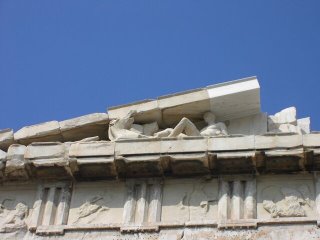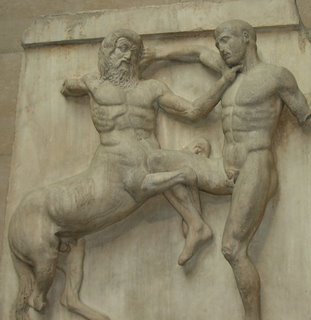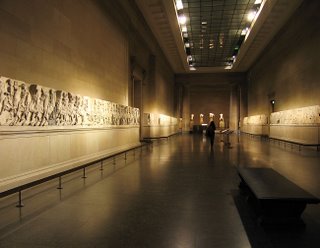Sculpture of The Parthenon. Athens, Greece. Marble, sculptural decoration 438-432 BC.

Okay, I lied. I'm not done with the Parthenon. I wanted to abandon it, because there's so freaking much I want to say that I'll end up going nuts trying to do it, but I'm going to grit my teeth and do this thing. And it's all for you. I hope you're grateful. In fact, today I'm gonna have to pull out multiple photos - it's like Christmas in June!
So today, in as few words as possible, I'm going to tell you about the Parthenon's sculptural decoration. All of the sculptural work was overseen by Pheidias, one of the greatest sculptors of classical Greece. His greatest contribution to the Parthenon is probably the giant statue of Athena he made for the interior. This statue is also called the "chryselephantine" statue of Athena- people call it this a) to signify that it was made of ivory and gold, and b) to make everyone else around them feel stupid. The statue stood about 40 feet tall, and was so large that the dimensions of the Parthenon had to be altered to make her fit. She had a spear in one hand, a Nike (a goddess of victory) in the other, and had a helmet and a big old shield. You notice I'm speaking in the past-tense. Athena was looted by some emperor and taken to Constantinople, and it's there that she was destroyed. So no pictures of her.
The photo I've posted above shows what once was the location of two more important elements of the Parthenon: the pediment sculptures and the metopes. See, back in 1801 this Brit named Lord Elgin came to Greece and got special permission to make drawings and casts of the Parthenon, and remove some sculpture from nearby buildings. Well, Lord Elgin interpreted this as, "Help yourself, buddy!" So he basically looted the whole thing. Most of the Parthenon's sculpture is now in the British Museum - these pieces have been dubbed the "Lord Elgin Marbles." Naturally, Greece wants them back, but the Brits have refused. There was a really big effort to reclaim the marbles in time for the Athens Olympics, but no dice.
So, let me explain what is missing from this photo. The triangle at the top is part of a pediment - you remember pediments, right? I just talked about them yesterday. So some really nice work was sculpted and put into these pediments. Below is a photo of some of the surviving pediment sculpture (in the British Museum, of course). Believe it or not, these statues were originally painted, in really bright, pretty garish colors. Most traces of paint have been removed by restorers who thought they shouldn't be there, which is really a shame.

But back to the photo at the top. In addition to the pediment, you can also see where the metopes were. See those groupings of three lines? (I can't think of a better way to describe them, sorry.) Those are called triglyphs. Those squares in between the triglyphs? Those are the metopes. As you can see, they're pretty much gone, and what wasn't looted has pretty much been destroyed by acid rain. Below is one metope from the Parthenon that shows a fight between a Lapith and a Centaur. In mythology, Centaurs are horse-men, and Lapiths are sort of their distant cousins. This is a scene of a big fight the two groups got into while they were attending a wedding. Honestly. But then, weddings make me pretty irritated, too.

And finally, we come to the Panathenaic Frieze. This frieze surrounded the exterior walls of the cella. This thing is bigger than you might imagine. It's 3 feet, 5 inches tall, and 524 feet long. It's not certain, but it's thought that the frieze represents the Panathenaic Procession, sort of a big parade that honored Athena and was held every four years. What makes this unique is that it depicts normal human beings - almost all Greek sculpture is of mythological figures or great heroes, not old Joe Blow walking down the street. Below is a photo of the frieze on display in the British Museum.

And that concludes my very short tour of the Parthenon. If any of this has piqued your interest, I suggest you go to Wikipedia, or find a book or something that gives you some greater detail.




0 Comments:
Post a Comment
<< Home